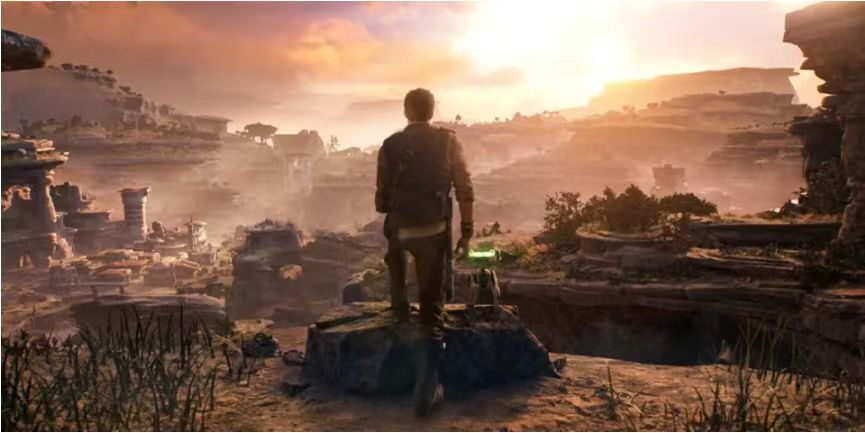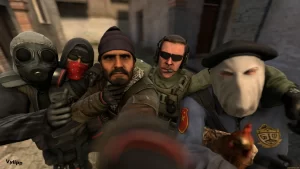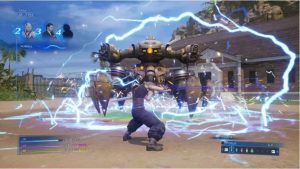1.Multi-interactive Behaviors Introduced by RAB Games
In shooting mobile games, actions such as “fire,” “move,” and “change perspective” are the most commonly used interactive behaviors by players, allowing for a basic shooting control experience. As the gameplay expands, shooting games have incorporated the experience of “skills,” transforming the shooting experience beyond solely “aiming and shooting.” The timing of using skills and strategic coordination add variety to the competitive process.
Beyond the fundamental actions mentioned above, there are numerous other in-game mechanics, particularly in tactical competitive games, that have emerged with the expansion of gameplay, incorporating new dimensions of interaction. For instance, equipment advancement allows players to pick up higher-tier gear to increase their chances of survival, departing from the traditional “equal for all” approach in team-based modes, as valuable resources gradually gravitate towards survivors. Additionally, the inclusion of expansive maps requires players to use markers, terrain exploration, and strategize their movement and objectives. Moreover, there are various scene-related interactions, such as using ziplines, opening doors, and utilizing vehicles, which add depth to the gameplay experience.
These interactions, being secondary to the core mechanics, can be facilitated on the PC platform through preset shortcut prompts to assist players in achieving the desired actions. However, on mobile screens, designing the UI elements’ logical placement presents a challenge for interaction designers to address. Let’s delve into the considerations relevant to this design aspect.
2. Diversification of Backpacks Due to Game Genres
In the conventional understanding of games, the “backpack” serves as a storage system for players to keep their collected items, with most of the acquired items being presented within it. This holds especially true for RPG-type games, where the backpack essentially represents the entirety of a character’s possessions. As a result, considering the player’s usage scenarios, the management of the backpack becomes a system of great interest and high in-game utility.
Regarding the utilization of backpacks, RPG games often store a vast amount of resources in them, with specific contexts and objectives. The backpack largely serves as a “medium” to manage these resources, and there is also a portion dedicated to immediate needs during battles, typically comprising supplies related to the enhancement of attributes, such as health and mana. However, such combat-related supplies often have dedicated shortcuts within the battle interface. In this context, the primary focus of the backpack is on categorizing and organizing resources.
In many RPG games, players can often find categorized backpacks with a “sort” function. Similar items are placed together based on their quality, with the main focus being on enabling players to quickly locate items for immediate “use.”
In FPS games, the design of backpacks differs based on the gameplay modes and mechanics.
In team-based competitive modes, the emphasis is not on providing large storage capacity, but rather on offering a limited quantity of supplies. While some gameplay styles may allow players to accumulate resources by looting enemy supplies, the storage limit for such resources is typically low. Overall, the gameplay experience focuses more on the “combat” aspect.
In Battle Royale (BR) games, a significant amount of automation and HUD convenience buttons are often present. Players’ demand for the backpack is not primarily centered around usage but rather on “discarding” items. With the assistance of an automatic looting mechanism, players tend to pick up a considerable number of items, some of which may be of no use to them. As a result, the frequent action concerning the backpack is the act of “discarding” items based on their needs at different stages of the game. Due to this, many pioneering products have implemented convenient interactions for “discarding,” such as drag-and-drop to a designated area or item splitting for easier disposal.
(Note: The translation assumes that the original context refers to “discarding” rather than “use,” as indicated by the explanation provided.)

Many PC-based shooting games adopt a full-screen display mode, which offers the advantage of efficiently showcasing all the items, facilitating quick judgment for players. Additionally, players can easily access and exit the backpack using shortcut keys like “Tab” and “ESC.” Particularly in some narrative-driven single-player shooting games, the backpack is designed with a full-screen presentation. When used, it pauses the game process, and players enter a full-screen interface, providing ample time for organizing the backpack.
In online real-time competitive shooting games, a full-screen display maximizes the visibility of items, enabling players to make efficient judgments. However, using a full-screen display also carries certain risks, as the battlefield’s “visibility” is of utmost concern to players. Therefore, alternative design approaches are adopted to mitigate these risks. For instance, in “APEX,” the battle backpack employs a “Gaussian blur” effect as the background. Players can vaguely see the scene behind through the mask, allowing them to quickly react to any incoming damage or enemies. Similarly, in “PlayerUnknown’s Battlegrounds (PUBG),” when opening the backpack, a semi-transparent black mask is used to ensure adequate visibility, highlighting the importance placed on maintaining a clear view of the surroundings for safety.
(Note: The translation assumes that “battle backpack” refers to the in-game backpack used during combat scenarios.)
3. Trade-offs in Shooting Game Design: Efficiency and Field of View
In shooting mobile games, many products opt for a “half-screen” display, considering three key factors:
- Core safety field of view.
- Ensuring continuous control and movement capability.
- Convenience for right-hand operations.
The term “safety field of view” is frequently mentioned in shooting games. To strike a balance between providing players with immediate control and retaining a clear view of the surroundings despite significant UI elements on the HUD, compressing the display of items becomes a relatively optimal choice, even if it sacrifices some browsing efficiency. For instance, the early attempt in tactical competitive gameplay by “Wilderness Action” involved a 2/3 half-screen backpack design, but it still caused a considerable amount of obstruction to the field of view.
In subsequent games, the obstruction area caused by the backpack was further reduced. For instance, “Peacekeeper Elite” decreased the number of displayed items and simplified the layout to a vertical list for better right-hand operation. “Call of Duty: Mobile” split the backpack and distributed its UI elements around the screen to minimize field of view obstruction. “Fortnite” and “OMEGA” took it a step further by simplifying items to icons and providing concise firearm information.
Similarly, in “Apex Legends,” a 1/2 half-screen backpack design was implemented, and a new “Quick Backpack” interaction was added to the HUD. The goal was to display backpack information in the smallest possible area, satisfying the core needs of players to replace accessories and discard items while preserving a significant portion of the field of view.
The examples mentioned above illustrate how different game designs adopt varying display methods on different devices, ultimately balancing the trade-offs between “efficiency” and “field of view.” In the context of player movement and the need for clear visibility when facing sudden enemies, maintaining a clear field of view becomes a necessary condition for players to make informed decisions. The limitations of narrow mobile displays inherently entail some sacrifice in terms of efficiency. This principle of prioritizing safety field of view over operational efficiency is also applied to other combat situations.
5 . Facilitating Teammate Cooperation
In multiplayer online competitive shooting games, teamwork is an essential element for success, whether it involves sharing equipment or coordinating objectives. Information sharing within the team is crucial for victory. Besides traditional voice and text communication, another vital means of conveying information to teammates is through marking or pinging. This essentially acts as a convenient way of communicating in-game, making it an indispensable feature for FPS games with strong team collaboration. Markings typically revolve around signals related to encountering enemies, marking resources, and indicating specific coordinates.
One well-known example of this feature is the ping system in “Apex Legends” (PING). It was reportedly developed by EA’s development team within a month as an in-game communication system without the need for voice communication. The system includes eight different ping signals that cater to players’ marking needs. Players can quickly utilize the ping system by holding down the mouse scroll wheel and dragging in a specific direction. Teammates can promptly respond to these marked signals, fostering effective team cooperation.
The marking feature has gradually been incorporated into mobile games as well, though it typically requires the addition of buttons to the interface. Consequently, amidst the numerous HUD functions, the positioning of the marking feature can become somewhat awkward. While it serves as an essential means of communication for teammate cooperation, it may not be frequently used, and its emphasis varies in different games. Below are some examples of commonly used interaction methods for marking in various games:
- Independent Marking Example: In “Wilderness Action,” the marking feature is relatively straightforward and limited to items. Players can individually mark items when picking them up. The advantage of this approach is low cognitive cost, but it may increase the UI area of the “pick-up list.”
- Aim-based Marking Example: “Call of Duty” and “Peacekeeper Elite” (PUBG Mobile) are two successful shooting mobile games that employ this method. Players hold down the “marking” button, use the crosshair to aim, and then utilize the marking feature. This approach is more lightweight compared to marking items one by one, suitable for games with lower-frequency sharing of resources. However, there are subtle differences in the user experience between the two. In “Peacekeeper Elite,” where there is a wide range of content that can be marked, the UI display area is more extensive. Utilizing a “free-drag” method allows players to quickly reach the desired signal. On the other hand, in “Call of Duty,” only four types of signals can be marked, each corresponding to a specific direction. Employing a “sliding snap” method is sufficient to use the marking feature.
- Automated Marking
Example: “Apex Legends”
In “Apex Legends,” the marking feature differs significantly from its PC counterpart. By default, there are only two marking options: “Go here” and “Enemy spotted.” Players can easily perform marking by swiping left or right. Compared to the eight different signals available in the PC version, this mobile adaptation has undergone substantial simplification. Additionally, the game triggers some automated marking functions in specific scenarios, such as marking resources or signaling enemy presence, further streamlining player actions.
Why opt for such simplification?
On one hand, it considers the inconvenience of players’ gaming experience with complex operations. On the other hand, adhering to the “Miller’s Law” in interaction design, having a number of signals beyond normal memory capacity can hinder players’ judgment efficiency. In “Apex Legends,” items possess a “rarity” feature, i.e., white < blue < purple < gold < red. To address the general scenario where players highly desire higher-rarity items, the system incorporates this “rarity” attribute to mark items in layers, reducing the frequency of player-initiated marking.
However, automation can also lead to various issues, such as marking items not required by teammates or frequent marking prompts causing distractions. This necessitates more refined design concerning players’ combat scenarios. For example, during combat phases, such information might be hidden or downplayed, avoided for a certain period, or even offer a toggle for blocking such automated features, all of which require more comprehensive rule-making.
When “gunplay” is no longer the sole experience in shooting games, interactive environmental experiences become additional behavioral variables designers must consider. As mentioned earlier, BR mode has enriched gameplay with various interactive actions like terrain interaction and interactive items such as doors, ziplines, and vehicles. Moreover, looting items and looting enemies’ boxes are part of the BR gameplay experience, contributing to its enjoyment. For instance, opening doors in buildings can serve as a tactic for defense and offense, and strategic use of vehicles can be employed to block passages or bridges.
While these features may not have the same priority as basic actions like movement, running, jumping, and crouching, they are essential interactions that players must engage in to advance in a single match. As such, they should generally be placed within the secondary interaction hot zone. This requires designers to apply an “opportune contextualization” design approach. Here are some ideas I consider relevant:
- Display timely based on the scene’s status and hide during normal states.
- Provide automated or convenient operations.
- Distinguish operation priorities and implement effective mutual exclusion rules.
When the number of interactive buttons increases due to various “interactive” features in a scene, considerations should be given to overlap and mutual exclusion, often prioritizing based on the usage scenario. A common practice is to automate certain actions familiar to players, such as opening doors or climbing, through the “automation” mode. However, this automation may impact more advanced players, so a certain degree of freedom must be maintained. For instance, options like “on/off switches” can be provided, or data can be collected through automatic defaults and analyzed for optimal feedback.
(Note: “Apex Legends” is mentioned as “APEXM” in the original text and is translated accordingly.)




